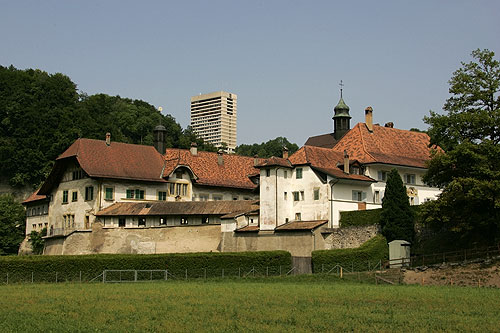|
La Maigrauge Abbey
La Maigrauge Abbey or Magerau Abbey (french: Abbaye de la Maigrauge; german: Abtei Magerau) is a monastery of Cistercian nuns located in Fribourg, Switzerland, and founded in 1255. The abbey is situated on the Sarine River and lies on the border between French-speaking and German-speaking Switzerland. The community is bilingual. History Origins In the mid-1250s, a small group of women came together in the region of Fribourg to follow a life of prayer under the guidance of the Rule of St. Benedict. They seem to have been neither Beguines nor aristocrats, as so many foundresses of women's monasteries were. Their names have not even been preserved. They were given permission to live as a religious community by the pastor of Taval, in a document dated 3 July 1255, which they consider their date of foundation. The community, was allowed to live at the far western end of the parish, in a location called Richenza, an isolated, inhospitable terrain, surrounded by mountains. Four years ... [...More Info...] [...Related Items...] OR: [Wikipedia] [Google] [Baidu] |
Protestant Reformation
The Reformation (alternatively named the Protestant Reformation or the European Reformation) was a major movement within Western Christianity in 16th-century Europe that posed a religious and political challenge to the Catholic Church and in particular to papal authority, arising from what were perceived to be errors, abuses, and discrepancies by the Catholic Church. The Reformation was the start of Protestantism and the split of the Western Church into Protestantism and what is now the Roman Catholic Church. It is also considered to be one of the events that signified the end of the Middle Ages and the beginning of the early modern period in Europe.Davies ''Europe'' pp. 291–293 Prior to Martin Luther, there were many earlier reform movements. Although the Reformation is usually considered to have started with the publication of the '' Ninety-five Theses'' by Martin Luther in 1517, he was not excommunicated by Pope Leo X until January 1521. The Diet of Worms of May 1521 ... [...More Info...] [...Related Items...] OR: [Wikipedia] [Google] [Baidu] |
Romont
Romont (; frp, Remont ) is a Municipalities of Switzerland, municipality and capital of the district of Glâne (district), Glâne in the Cantons of Switzerland, canton of Fribourg (canton), Fribourg in Switzerland. History Romont is first mentioned in 1177 as ''in Rotundo Monte''. In 1244 it was mentioned as ''Romont''. The municipality was formerly known by its German name ''Remund'', however, that name is no longer used. The oldest trace of human settlement in Romont is five Hallstatt culture, Hallstatt era tumuli in the village of Bossens. The ruins of several other prehistoric settlements have been discovered including the foundation of a Switzerland in the Roman era, Roman era building at Bochanat. The alleged founding of Romont in 921 by the Kingdom of Burgundy, Burgundian King Rudolph II of Burgundy, Rudolph II is likely a legend. A document from 1177 from the Abbey of Hauterive mentions the Romont as a wooded hill. In 1239 Anselme (or Nantelme) sold the rights to ... [...More Info...] [...Related Items...] OR: [Wikipedia] [Google] [Baidu] |
Abbaye De La Fille-Dieu
The Abbaye de la Fille-Dieu is a Cistercian monastery located near the town of Romont in the Swiss Canton of Fribourg. Founded as a Benedictine priory in 1268, and continuously occupied by a community of nuns since its establishment, the alpine abbey is a Swiss heritage site of national significance. Heavily altered through its history, Fille-Dieu was restructured by economic turmoil, fire, additions and unsympathetic alterations. In 1906 the abbey became affiliated with the Trappists, and between 1990 and 1996 an internationally notable restoration was undertaken, modernising the monastic buildings, restoring the abbey church to its original volume, and preserving its rediscovered medieval murals, with the only contemporary element a suite of stained glass windows commissioned from the British artist Brian Clarke Brian Clarke (born 2 July 1953) is a British painter, architectural artist and printmaker, known for his large-scale stained glass and mosaic projects, symbolist ... [...More Info...] [...Related Items...] OR: [Wikipedia] [Google] [Baidu] |
Canon Law
Canon law (from grc, κανών, , a 'straight measuring rod, ruler') is a set of ordinances and regulations made by ecclesiastical authority (church leadership) for the government of a Christian organization or church and its members. It is the internal ecclesiastical law, or operational policy, governing the Catholic Church (both the Latin Church and the Eastern Catholic Churches), the Eastern Orthodox and Oriental Orthodox churches, and the individual national churches within the Anglican Communion. The way that such church law is legislated, interpreted and at times adjudicated varies widely among these four bodies of churches. In all three traditions, a canon was originally a rule adopted by a church council; these canons formed the foundation of canon law. Etymology Greek / grc, κανών, Arabic / , Hebrew / , 'straight'; a rule, code, standard, or measure; the root meaning in all these languages is 'reed'; see also the Romance-language ancestors of the Engli ... [...More Info...] [...Related Items...] OR: [Wikipedia] [Google] [Baidu] |
Canonical Visitation
In the Catholic Church, a canonical visitation is the act of an ecclesiastical superior who in the discharge of his office visits persons or places with a view to maintaining faith and discipline and of correcting abuses. A person delegated to carry out such a visitation is called a visitor. When, in exceptional circumstances, the Holy See delegates an apostolic visitor (or visitors) "to evaluate an ecclesiastical institute such as a seminary, diocese, or religious institute ..to assist the institute in question to improve the way in which it carries out its function in the life of the Church," this is known as an apostolic visitation. Usage The practice was reaffirmed in the Catholic Church by the Council of Trent (1545 to 1563) in these words: Of the purpose of visitation the Council says: Rights of visitation The right of visitation belongs to all prelates who have ordinary jurisdiction over persons in the external forum. The pope through his delegates may institute a vis ... [...More Info...] [...Related Items...] OR: [Wikipedia] [Google] [Baidu] |
First Aid Room
A first aid room or medical room, also known as an infirmary, is a room in an establishment (e.g., a school, factory, sports venue, or airport) to which someone who is injured or taken ill on the premises can be taken for first aid and to await the arrival of professional emergency medical services. According to guidance issued in 1981 in the UK, a first aid room should be clearly signposted, easily accessible, and contain the following: * a sink and drinking water * first aid materials (which may include protective equipment and blankets) * an examination/medical couch * a telephone or other communication equipment * a record book for recording incidentsThe Health and Safety (First-aid) Regulations 1981 - Approved Code of Practice and Guidance In the United Kingdom, a first aid room is required in some chemical factories, construction sites, and premises at a distance from medical services. In some cases, the room may be used for other purposes when not required for first aid. ... [...More Info...] [...Related Items...] OR: [Wikipedia] [Google] [Baidu] |
Dormitory
A dormitory (originated from the Latin word ''dormitorium'', often abbreviated to dorm) is a building primarily providing sleeping and residential quarters for large numbers of people such as boarding school, high school, college or university students. In some countries, it can also refer to a room containing several beds accommodating people. Terminology Dorm and residence hall The terms "dorm" is often used in the US. However, within the residence life community, the official term "residence hall" is preferred. According to the University of Oregon, their facilities "provide not just a place to sleep, but also opportunities for personal and educational growth. Highly trained Residence Life staff and Hall Government officers support this objective by creating engaging activities and programs in each hall or complex." In the UK, the preferred term in the context of student housing is "halls," short for "halls of residence." In English-speaking Canada, the common term is "r ... [...More Info...] [...Related Items...] OR: [Wikipedia] [Google] [Baidu] |
Compline
Compline ( ), also known as Complin, Night Prayer, or the Prayers at the End of the Day, is the final prayer service (or office) of the day in the Christian tradition of canonical hours, which are prayed at fixed prayer times. The English word is derived from the Latin , as compline is the completion of the waking day. The word was first used in this sense about the beginning of the 6th century by St. Benedict in his ''Rule'' (''Regula Benedicti''; hereafter, RB), in Chapter16 an and he even uses the verb ''compleo'' to signify compline: "Omnes ergo in unum positi compleant" ("All having assembled in one place, let them say com ... [...More Info...] [...Related Items...] OR: [Wikipedia] [Google] [Baidu] |
Room
In a building or large vehicle, like a ship, a room is any enclosed space within a number of walls to which entry is possible only via a door or other dividing structure that connects it to either a passage (architecture), passageway, another room, or the outdoors, that is large enough for several people to move about, and whose size, fixtures, furnishings, and sometimes placement within the building or ship support the activity to be conducted in it. History Historically, the use of rooms dates at least to early Minoan civilization, Minoan cultures about 2200 BC, where excavations at Akrotiri (prehistoric city), Akrotiri on Santorini reveal clearly defined rooms within certain structures. In early structures, the different room types could be identified to include bedrooms, kitchens, bathroom, bathing rooms, closets, reception rooms, and other specialized uses. The aforementioned Akrotiri excavations reveal rooms sometimes built above other rooms connected by staircases, bath ... [...More Info...] [...Related Items...] OR: [Wikipedia] [Google] [Baidu] |
Breast Cancer
Breast cancer is cancer that develops from breast tissue. Signs of breast cancer may include a lump in the breast, a change in breast shape, dimpling of the skin, milk rejection, fluid coming from the nipple, a newly inverted nipple, or a red or scaly patch of skin. In those with distant spread of the disease, there may be bone pain, swollen lymph nodes, shortness of breath, or yellow skin. Risk factors for developing breast cancer include obesity, a lack of physical exercise, alcoholism, hormone replacement therapy during menopause, ionizing radiation, an early age at first menstruation, having children late in life or not at all, older age, having a prior history of breast cancer, and a family history of breast cancer. About 5–10% of cases are the result of a genetic predisposition inherited from a person's parents, including BRCA1 and BRCA2 among others. Breast cancer most commonly develops in cells from the lining of milk ducts and the lobules that supply these ... [...More Info...] [...Related Items...] OR: [Wikipedia] [Google] [Baidu] |
Abstinence
Abstinence is a self-enforced restraint from indulging in bodily activities that are widely experienced as giving pleasure. Most frequently, the term refers to sexual abstinence, but it can also mean abstinence from alcohol, drugs, food, etc. Because the regimen is intended to be a conscious act, freely chosen to enhance life, abstinence is sometimes distinguished from the psychological mechanism of repression. The latter is an unconscious state, having unhealthy consequences. Abstinence in religion Abstinence may arise from an ascetic over indulgent, hasidic point of view in natural ways of procreation, present in most faiths, or from a subjective need for spiritual discipline. In its religious context, abstinence is meant to elevate the believer beyond the normal life of desire, to a chosen ideal, by following a path of renunciation. In Judaism, Christianity and Islam, amongst others, pre-marital sex is prohibited. Judaism For Jews, the principal day of fast is Yom Kippur, ... [...More Info...] [...Related Items...] OR: [Wikipedia] [Google] [Baidu] |

.jpg)





